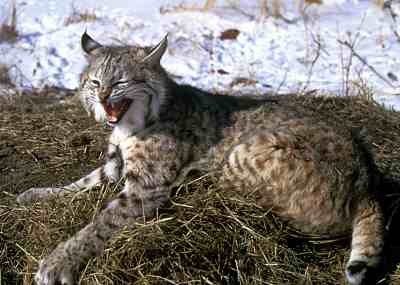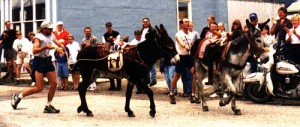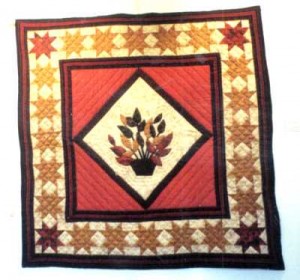Article by Lynda La Rocca
Wildlife – March 2004 – Colorado Central Magazine
YOU COULD SAY I’m living proof that good things come from being compulsive. If I hadn’t suddenly felt driven to wash the dog’s bowls, I wouldn’t have been standing at the kitchen sink at our home in Twin Lakes one afternoon last November, gazing out the window in that half-trance I sometimes sink into when I’m doing something as mind-numbing as, well, washing dishes for a dog.
As I scrubbed, a movement in our backyard woodpile caught my eye. Whatever I’d seen was white. My first thought was that it must be a weasel because weasels view our woodpile as a kind of rodent smorgasbord. (Don’t ask me whether these little gluttons are long-tailed or short-tailed weasels, though. In my book, all weasels are one.)

But this animal hadn’t moved in that sinuous, undulating way that weasels move. I looked again and caught a glimpse of what I automatically assumed was a house cat. Yet this critter would have to rate as the mother of all house cats. I’ve lived in central Colorado since 1982, and I’d never seen anything like this before. I dashed across the room and grabbed my binoculars for a closer look.
No question. The creature now staring back at me was Lynx rufus, a.k.a. the bobcat. What I’d first noticed was the white underside of its black-tipped tail as the cat prowled the jumbled stacks of cordwood and weathered boards. Now it was in full view and I could see the entirety of its stubby tail with its black tip, its brownish-red-gray coat with dark spots and what almost looked like dark stripes on its legs. Even its pointy black ear tufts were perfectly visible.
I watched “my” bobcat for maybe two or three minutes as it continued searching the woodpile, then wandered toward the trees and finally disappeared into the forest.
WHEN MY HUSBAND, Steve, arrived home about a half-hour later, we jumped into the car and took off on a fruitless search for the cat. Even now, several months later, I can’t look at that woodpile without hoping for another bobcat sighting. Given my record thus far, I’m on track for the next one in 2024.
And I’m sure that’s just fine with the bobcat. Although active day and night, bobcats are shy and furtive creatures, characteristics that come in handy when your hunting technique involves lying in wait for hours near game trails or dropping noiselessly from tree branches to pounce on prey ranging from insects, lizards, frogs, and birds to mice, voles, squirrels, and rabbits.
Male bobcats are slightly larger than females, growing up to 30 inches in length and sometimes weighing more than 35 pounds. Still, it’s hard to imagine a cat that size having a 10-foot springing range and the ability to occasionally bring down animals as large as adult deer.
While bobcats are considered endemic to North America, with a range extending throughout most of the lower 48 states, into southern Canada, and as far south as Oaxaca, Mexico, exact or even approximate overall population figures are hard to come by. Although only a Mexican subspecies, Lynx rufus escuinapae, is listed as endangered, some wildlife biologists nevertheless believe that bobcat numbers are declining due to hunting and habitat loss. Others, however, maintain that bobcats have adapted well to increasing human pressures and that their population is stable.
ONE STATISTIC that I did manage to unearth, from Project Wildlife in San Diego, California, is, although outdated, nevertheless chilling: From 1977-1978, over 85,000 bobcat skins were harvested in North America.
In Colorado, hunters must have a “furbearer license” to take bobcats during a season which runs from December 1, 2003 through February 28, 2004. Last year, the Colorado Division of Wildlife (DOW) tagged 622 bobcat carcasses, 580 of them “harvested” by hunting or trapping in 41 Colorado counties. (The remainder were listed as roadkill or died of unknown or miscellaneous causes.)
Hunters must rigorously guard against confusing bobcats with their northern cousin the Canada lynx, the latter designated a threatened species four years ago by the U.S. Fish and Wildlife Service.
Until recently considered extinct in Colorado, the lynx is making a comeback due to a controversial DOW reintroduction program which began when 96 transplanted lynx were released in the state during 1999 and 2000. Despite criticism generated by the deaths of many of the initially released lynx, the DOW released an additional 33 animals in 2003. That same year, the DOW also documented the first successful reproduction of the lynx with the discovery of 16 kittens in six separate dens.

The arrival of lynx may also provide additional opportunities for feline socialization, although not in a way that’s generally pleasing to experts in these matters. It remains to be seen whether bobcats and lynx will interbreed in Colorado as they have in states like Maine and Minnesota and, if they do, whether and how such hybridization will affect future lynx reintroduction efforts.
In 2003, DNA analysis of samples from cats exhibiting traits common to both species provided the first scientifically documented proof of Canada lynx-bobcat hybridization in populations from both states. One Maine hybrid, a female, was located by a University of Maine graduate student who also observed three kittens nearby. Further examination determined that this lynx-bobcat hybrid had indeed reproduced successfully.
WHILE THE RANGES of these genetically distinct but closely related species overlap in some states, obviously including Maine, lynx are more highly adapted to living in areas with deep snow cover. Their large paws function like snowshoes, making them adept at catching their favorite prey, the snowshoe hare.
The bobcat’s less picky eating habits enable it to out-compete populations of larger carnivores like cougars and coyotes (which prey on bobcats if they can catch them). And lynx have the advantage over bobcats only in areas where heavy snow hinders the latter’s hunting ability.
So if you notice a strange movement in any area where there’s sufficient cover for hiding and hunting, take a closer look. You may find a pair of yellow eyes staring back at you and find yourself privileged to have glimpsed one of the most beautiful of all of North America’s wild cats.
Lynda La Rocca watches for wildlife when she’s not writing in Twin Lakes.




